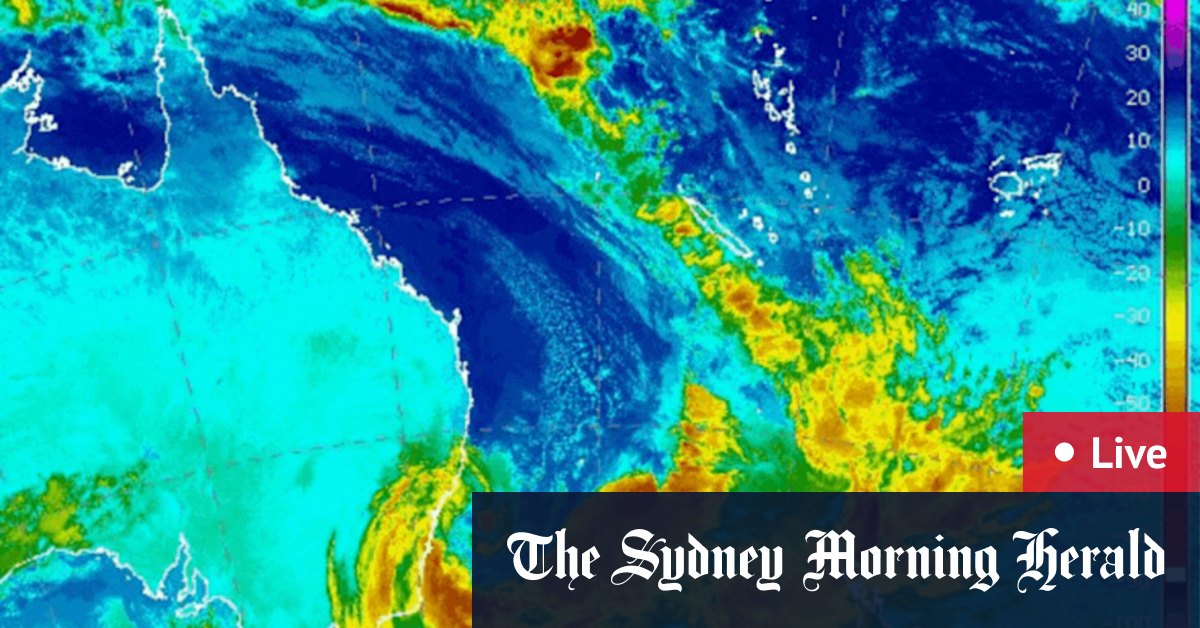We’re sorry, this feature is currently unavailable. We’re working to restore it. Please try again later.
Add articles to your saved list and come back to them any time.
1 of 4
Welcome to our coverage of the “bomb cyclone” event that has continued to lash coastal NSW after a night of wild weather brought down trees and cut power to thousands of homes.
Here’s what you need to know this afternoon.
We reported earlier that WaterNSW has said Sydney’s main reservoir for water supply, the Warragamba Dam, is expected to experience a moderate spill later today. The agency’s website says the dam is currently at 98 per cent capacity.
The NSW Rural Fire Service has shared this footage from the Nepean Dam, which WaterNSW said would continue to spill today after it reached full capacity last night. Watch below.
The SES has responded to thousands of calls for assistance across the state, including performing 10 flood rescues.
More than 3400 call-outs have been made to the SES since the beginning of the storm – with 2500 calls made in the 24 hours to 2pm Wednesday.
Most of the SES call-outs have been to the Greater Sydney metro area, of which they attended 860, followed by the Northern Zone (Central Coast to Nambucca) with 824 call-outs, and the Southern East Zone (encompassing Tablelands and Snowy Mountains regions) with 742.
SES crews are still responding to storm-related incidents across the state, with NSW SES Assistant Commissioner Nicole Hogan warning people should remain vigilant with more rain forecast today.
“Volunteers have been kept busy overnight and into today as strong wind gusts brought down trees, powerlines and damaged properties,” she said.
“We have more than 2,000 members responding to incidents, along with emergency service partners. An additional crew from ACT SES is deploying to assist in the area later today … We urge everyone to stay well clear of fallen trees and power lines as we work to clean up the damage.”
”While conditions may be easing in some areas, we ask communities to remain vigilant. Never drive, walk or play in floodwaters.”
Sydney commuters are being advised to check advice before they travel and allow extra time tomorrow morning, as many services return to normal after the wild weather of the past two days brought chaos to the road, ferry and rail networks.
Speaking at 4pm, Transport for NSW Coordinator General Howard Collins told Seven News an update would be provided later tonight on disruption between St Mary’s and Penrith, where crews are working to restore service after a second tree fell, affecting T1 and Blue Mountains services.
Crews work to remove debris on a Transport NSW train between Penrith and St Mary’s today.Credit: Sam Mooy
Another tree which fell in the area earlier right as a train was passing, piercing the driver’s cabin but causing no injuries.
Collins said an incident when a tree fell on power lines above the train at Dora Creek would cause continued disruption on Central Coast & Newcastle (CCN) Line. “Expect on the Central Coast heading towards Newcastle interrupted [service] between Wyong and Fassifern for the next at 48 hours,” he said. Bus services are operating between the two disrupted locations.
Collins said light rail and coastal services on the Illawarra and T4 lines were running well, and were less congested after many heeded advice to avoid non-essential travel today. Ferry services have resumed normal operations after swell in the harbour eased.
“Roads – slow crawl, allow extra time,” said Collins, noting many roads remained flooded, with diversions in place. “The advice tomorrow is check before you travel – make sure these overnight condition haven’t caused any further disruption.”
Welcome to our coverage of the “bomb cyclone” event that has continued to lash coastal NSW after a night of wild weather brought down trees and cut power to thousands of homes.
Here’s what you need to know this afternoon.
About 17,300 properties remain without power in NSW after a destructive night of weather prompted an extensive clean-up effort, reconnecting tens of thousands of homes across the state.
Energy provider Ausgrid, which has worked to restore power to more than 35,000 customers in the last 24 hours, said earlier this afternoon that 6700 were still without power across NSW.
The Hunter region was the worst affected, with 3000 people without power, the Central Coast with 2500, and 1400 in the Sydney region.
“As the wild weather continues, there could be more outages throughout the day – as well as flooding and hidden hazards, particularly around fallen or damaged trees,” Ausgrid said in a statement.
Before 4pm, Ausgrid’s website had revised the number of customers affected to about 5700. Meanwhile, Essential Energy’s website said about 3000 of its customers continued to experience power outages, while Endeavour Energy’s website showed about 8600 properties remained without power.
Angry Wamberal home owners confronted Central Coast Council’s mayor and chief executive this morning as the east coast low battered homes teetering above the sand.
At a press conference on Wednesday morning, Mayor Lawrie McKinna and chief executive David Farmer were peppered with questions from locals wanting to know why, between council and the state government, no major protection works had been allowed to proceed at Wamberal and The Entrance North.
The bases of evacuated houses between Wamberal and Terrigal beaches have been battered again today the coastal low.Credit: Dean Sewell
McKinna said plans for interim works under the NSW Reconstruction Act were presented to residents on Monday, and would need to be sent to the Reconstruction Authority for approval. He said the council is “doing our very best” but had no answer for how homes would be protected in years to come.
“We have to come up with a long-term solution very, very quick, because we can’t keep coming back here every time there’s a swell,” he said.
Farmer said the state government needed to show leadership and find a long-term solution.
Earlier in the day, Premier Chris Minns reiterated his stance against a seawall for Wamberal and said that sand replenishment would be part of the solution, but couldn’t say what steps were next.
“It’s not something you can just click your fingers and fix,” he said.
WaterNSW has provided an update on the Warragamba Dam, saying the primary reservoir for Sydney’s water supply is “approaching full capacity and will experience a moderate spill overnight”.
The agency said the duration and volume would depend on further rainfall today, but predicted the spill would be around 60 gigalitres (or 60 billion litres) a day.
That might sound like a lot, but it would put today in the range of recent spilling events. The dam spilled at a rate of 240 gigalitres a day during downpours on June 7 last year.
WaterNSW said smaller dams at Cataract, Nepean, Cordeaux, Avon and Woronora started spilling last night and will continue to spill today.
“Fitzroy Falls, Tallowa, Greaves Creek and Medlow dams were already spilling, and will continue to do so,” it said.
Enjoy this afternoon’s flashes of sunshine if you’ve got them – another surge of bad weather could be on the way to parts of NSW when a secondary weather system swings close to the coast tonight.
The main low-pressure system is spinning off the Central Coast and tracking north-east while a secondary low to the south-east is heading towards land. Two low-pressure systems circling each other like this is known as the Fujiwhara effect.
Water vapour imagery released by the bureau shows the main low-pressure system tracking north-east while a secondary system brings more moisture, shown in green, to the southern coast.Credit: Bureau of Meteorology
Both systems are drawing on large amounts of atmospheric moisture, the bureau said, and could continue to bring heavy rain to parts of the NSW coast.
“That’s good news that it is moving away,” the Bureau of Meteorology’s Dean Narramore said of the main low. “That’s why we’ve seen some rains and winds ease through some parts of the NSW coast.
“But that second surge we’re going to see this afternoon and this evening is going to lead to an increase of rain through eastern Victoria and southern parts of NSW.”
That could bring a burst of wind and rain to the Illawarra and possibly Sydney this evening. Another 50 to 100 millimetres of rain could fall on the already saturated South Coast, he said.
Bodyboarders and surfers are braving huge swell on the Central Coast as residents evacuated from several beachfront properties at Wamberal and The Entrance North face a nervous wait ahead of high tide at 4pm.
People from dozens of houses along the water were asked to leave due to the danger of coastal erosion damaging their homes.
A man watches as the surf erodes the bank at Terrigal Beach.Credit: Dean Sewell
Home owner Chris Rogers of the Wamberal residents’ association said yesterday it was “madness” that works weren’t undertaken in the lead-up to the coastal low.
Heavy machinery has been moving sand to protect homes and locals said rock bags were brought to Pacific Street in Terrigal by council workers on Tuesday, but plans to place them in front of at-risk homes were abandoned when the weather system became too dangerous.
Large and powerful surf at Terrigal Beach on the Central Coast.Credit: Dean Sewell
A bodyboarder makes his way through excavators to go for a surf.Credit: Dean Sewell
Abnormally hot water off the coast partly fuelled the explosive intensification of the coastal low lashing NSW.
Sea temperatures sitting 1–3 degrees above average for months fanned the system’s energy and helped supply the moisture that fell as torrential rain, environmental scientist at CQUniversity Steve Turton said.
Watch how the spiralling system dumped rain along the coast over the past few days in the graphic below.
The most intense rainfall totals in the 24 hours to 9am today include:
Many areas on the South Coast had two months’ worth of rain hammer down in a day.
The risk of further gauge-smashing rainfall has now eased. The bureau now expects scattered showers across south-east NSW and patchy rain along the north and central coastline.
1 of 4
Copyright © 2025




